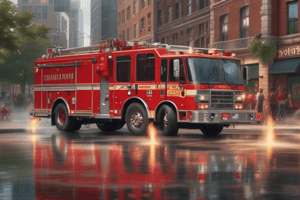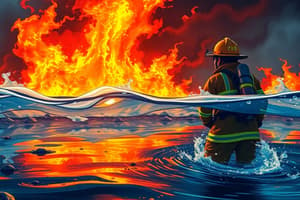Podcast
Questions and Answers
What is the primary purpose of extending an aerial ladder during water tower operations?
What is the primary purpose of extending an aerial ladder during water tower operations?
- To achieve accurate water penetration to the target (correct)
- To achieve maximum height
- To intimidate the fire
- To test the ladder's durability
What type of nozzles are equipped on TFS apparatus with waterway capabilities?
What type of nozzles are equipped on TFS apparatus with waterway capabilities?
- Both smooth bore and combination nozzles (correct)
- Only smooth bore nozzles
- Only combination nozzles
- Only fog nozzles
When should an aerial device be left raised?
When should an aerial device be left raised?
- When there is an ongoing operation (correct)
- When no use exists
- When the apparatus is being serviced
- When the operator is tired
What is the recommended climbing angle for an aerial ladder?
What is the recommended climbing angle for an aerial ladder?
Who should position the aerial as accurately as possible to the desired location?
Who should position the aerial as accurately as possible to the desired location?
What is the purpose of the Bresnan Distributor and Hose Kit?
What is the purpose of the Bresnan Distributor and Hose Kit?
When should the Creeper Controls be enabled?
When should the Creeper Controls be enabled?
What is the recommended extension height of an apparatus ladder for roof operations?
What is the recommended extension height of an apparatus ladder for roof operations?
What should be done before climbing an aerial ladder?
What should be done before climbing an aerial ladder?
What is the purpose of the TFS approved Fall Prevention Device?
What is the purpose of the TFS approved Fall Prevention Device?
When is it acceptable to reposition the aerial ladder?
When is it acceptable to reposition the aerial ladder?
What is the minimum clearance required for overhead wires?
What is the minimum clearance required for overhead wires?
What should be done to ensure water tower operation can commence without delay?
What should be done to ensure water tower operation can commence without delay?
What is the purpose of the ground spotter in water tower operations?
What is the purpose of the ground spotter in water tower operations?
What should be used in line at a hose coupling before the nozzle when using the VUM with a hose line?
What should be used in line at a hose coupling before the nozzle when using the VUM with a hose line?
What should be considered when operating an aerial device?
What should be considered when operating an aerial device?
Flashcards are hidden until you start studying
Study Notes
Water Tower Operations
- Aerial ladders should only be extended as far as necessary for accurate water penetration to the target.
- Extending the aerial to unnecessary heights is counterproductive.
Aerial Apparatus Equipment
- TFS apparatus with waterway capabilities are equipped with both smooth bore and combination nozzles.
- Straight streams are more effective for fire penetration and suppression, while fog streams are used for exposure protection and decon.
Bresnan Distributor and Hose Kit
- The kit is designed to be used with an elevated waterway (apparatus with the “Elevated Water Supply” attribute).
- It allows water to be applied to areas out of reach of hand lines or too dangerous for crews to operate hand lines from.
Aerial Operations Safety
- The aerial device should be extended 1-2 meters above the edge of the roof during roof operations.
- Aerial devices should not be left raised if not in use, and should be bedded when operations are completed.
- The ladder should be positioned no greater than 70 degrees for safe climbing angles.
Creeper Controls and Ladder Placement
- Creeper Controls can be enabled by the turntable operator and activated by a firefighter at the tip for final adjustments of the ladder placement.
- Creeper Controls should only be enabled when the firefighter at the tip is appropriately secured with a safety belt attached to a rung and with footplates in use.
Climbing and Fall Prevention
- Personnel shall climb the aerial ladder when it is in the desired position.
- Firefighters shall not ride the ladder while it is being raised from the bed.
- All rungs shall be aligned for safer ascent before climbing an aerial ladder.
- Personnel operating from an aerial apparatus shall be secured by a TFS-approved Fall Prevention Device.
Safety Precautions
- Apparatus ladders shall never be in contact with a structure.
- Safety shall never be compromised by overloading a ladder device.
- The operator at the turntable shall not reposition the aerial when any firefighter is on the ladder, unless the firefighter at the tip is incapacitated.
Limited Visibility Operations
- When water tower operations are conducted in limited visibility, a ground spotter should be utilized when the water tower stream is being repositioned near the edges of the fire building.
Valve Under Monitor (VUM) Operations
- Apparatus equipped with VUM enables the waterway to be used as an improvised standpipe.
- The TFS Standpipe Kit gate and pressure gauge shall be used in line at a hose coupling before the nozzle.
Electrical Hazards
- All wires shall be considered live.
- Clearance of 3 meters (10 feet) for overhead wires and 1 meter (3.3 feet) for TTC streetcar power lines shall be maintained.
- Caution must be taken to never provide a ground for an electrical circuit.
Studying That Suits You
Use AI to generate personalized quizzes and flashcards to suit your learning preferences.




